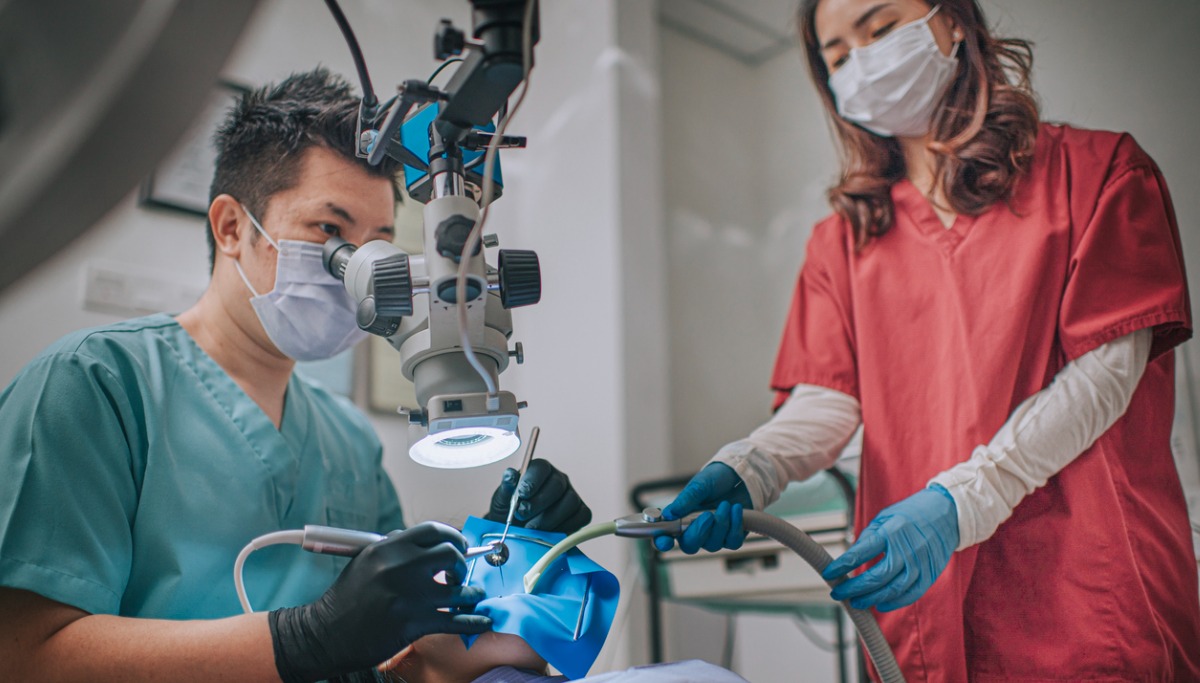Do you need antibiotics before your dental visit?
It had been common for most people with heart problems, and for people with prosthetic joint replacements to be prescribed a short course of antibiotics before their dental appointment (antibiotic prophylaxis). This was to prevent potential infection of the heart lining and valves (infective endocarditis) or replacement prosthetic joints (e.g., knee, hip) from the large number of bacteria that can potentially be released from the mouth into the bloodstream (bacteremia) after many common dental procedures, even cleanings. The immune system normally kills these bacteria, but antibiotic prophylaxis was given to persons with heart problems or prosthetic joints to provide extra protection against the risk of acquiring serious heart or joint infections after a dental appointment.
Medical experts have provided guidance over the years on appropriate use of antibiotics for certain patients before bacteremia-causing dental procedures. In recent years, this guidance has been updated.
In 2007 the American Heart Association guidance on administration of antibiotic prophylaxis changed to providing antibiotics only to those patients with cardiac conditions considered at “highest risk” of an adverse outcome from infective endocarditis. In 2015, the American Dental Association (ADA) provided new guidance on when it may be appropriate to consider antibiotic administration prior to dental procedures in patients with replacement joint implants. And, in 2016 the American Academy of Orthopaedic Surgeons (AAOS) also provided appropriate use criteria on when it may be appropriate to consider antibiotic administration prior to dental procedures in patients with replacement joint implants. And here’s why:
First, research experts in medicine and dentistry have found that the collective published evidence suggests that of the total number of cases of infective endocarditis (IE) that occur annually from any cause, the number of IE or prosthetic joint infections that occur after bacteremia-producing dental procedures are exceedingly small. Accordingly, only an extremely small number of cases of IE might be prevented by antibiotic prophylaxis before dental procedures even if it were 100% effective. And one would not expect antibiotic prophylaxis to be near 100% effective, however, because of the nature of the microorganisms and choice of antibiotics. The recommendation is that antibiotic prophylaxis is not necessary for most people, other than for certain cardiac or prosthetic joint patients who may be at the “highest-risk” for developing heart or joint infection (as listed below). Second, there can be considerable side effects from antibiotics including upset stomach, rash, diarrhea and, more importantly, allergic reactions, some of which can be life-threatening. The new guidelines acknowledge that the risk of antibiotic-associated adverse events exceeds the benefit, if any, from prophylactic antibiotic therapy. In addition, antibiotic overuse has led to a growing, worldwide problem from infections caused by bacteria that have become resistant to most common antibiotics. Bacteria develop resistance when they are prescribed too often or used inappropriately. Therefore, it is important to use antibiotic prophylaxis only in the right situations and with those people most at risk for infection. Third, studies suggest that of the exceedingly small number of cases of IE that are linked to oral bacteria, the vast majority of those cases result from random bacteremias caused by routine daily activities, such as chewing food, tooth brushing, flossing, use of toothpicks, use of water irrigation devices, and other activities.
The link between dental procedures, everyday oral activities, and bacteremia
Although studies do show a strong association between certain dental procedures and short-lasting (transient) bacteremia, they do not prove a direct link between dental procedure-associated bacteremia and infections in the heart or prosthetic joints. Numerous studies have also pointed out that transient bacteremia is common during normal oral daily activities, such as chewing, clenching, tooth brushing, and flossing. Given that the average person living in the United States has fewer than two dental visits per year, the frequency of bacteremia from routine daily activities is far greater than from dental appointments. Available evidence also supports that good oral hygiene and gingival health are associated with a reduced risk of developing bacteremia from these everyday oral activities.
Heart problems that call for antibiotics before dental procedures
Today, the American Heart Association (AHA) only recommends antibiotics before dental procedures for patients with the highest risk of infection, those who have:
- A prosthetic heart valve or who have had a heart valve repaired with prosthetic material
- A history of endocarditis
- A heart transplant with abnormal heart valve function
- Certain congenital heart defects including:
- Cyanotic congenital heart disease (birth defects with oxygen levels lower than normal), which has not been fully repaired, including in children who have had surgical shunts and conduits
- A congenital heart defect that has been completely repaired with prosthetic material or a device for the first six months after the repair procedure
- Repaired congenital heart disease with residual defects, such as persisting leaks or abnormal flow at, or adjacent to, a prosthetic patch or prosthetic device
If you’re not sure about the guidelines for your heart condition, check with your heart specialist. If you have one of these conditions, always tell your dentist. Also, alert your dentist if - you (or your child) are allergic to any antibiotics or other medications.
Antibiotic prophylaxis and joint surgery
In the past, people who have had a joint replacement, such as a hip or a knee replacement, were often prescribed antibiotic prophylaxis before dental procedures. While this still may be necessary for some individuals, in general, for patients with prosthetic joints, prophylactic antibiotics are not routinely recommended prior to dental procedures to prevent prosthetic joint infection.
The ADA and the AAOS have provided guidance on when it may be appropriate to consider antibiotic administration prior to dental procedures in patients with replacement joint implants. The AAOS guidance advises that most patients with replacement joints are not at risk for infection following dental procedures and do not require antibiotic administration. Prophylactic antibiotic therapy, however, should be considered for certain subsets of patients—primarily those with severely compromised immune systems related to AIDS/HIV, uncontrolled diabetes, chemotherapy, or a recent history of joint infection, along with those taking certain drugs for rheumatoid arthritis or to prevent organ transplant complications. The ADA recommends that prophylactic antibiotics should only be considered after consultation with the patient and orthopedic surgeon; in cases where antibiotics are deemed necessary, it is most appropriate that the orthopedic surgeon recommend the appropriate antibiotic regimen and, when reasonable, write the prescription.
If you have any questions about your situation, particularly if you have a significant immunodeficiency or a current or previously infected prosthetic joint, make sure to discuss your situation with your dentist and orthopedic surgeon or physician to determine the need for antibiotic prophylaxis.
Other uses for antibiotics in dentistry
If your dentist detects signs of an acute or chronic infection in your mouth, particularly when accompanied by fever, swelling or other signs, you may be prescribed antibiotics. Tooth infections occur when bacteria enter a tooth’s root, causing pain, tissue death, and buildup of pus. Called an abscess or abscessed tooth, this kind of infection can spread to other areas of the head and neck. Periodontal disease, also called gum disease, can lead to serious gum abscesses. Treatments for abscesses can include antibiotics, root canals, and tooth extractions.
Antibiotic prophylaxis before typical periodontal, third molar, implant or other surgeries is usually not necessary. But depending on your personal medical history, you may still be a candidate for premedication. For example, antibiotic prophylaxis might be useful for patients undergoing invasive dental procedures, who also have compromised immune systems, due to, for instance, diabetes, rheumatoid arthritis, cancer, chemotherapy and chronic steroid use.
Finally, always provide your dentist or physician with a complete medical history and discuss whether antibiotic prophylaxis before dental treatment is right for you. Also, remember that brushing, flossing, eating a good diet, and visiting your dentist will help maintain good oral health, prevent tooth and gum disease, and potentially avert the need for more aggressive dental procedures and medications.
Final thoughts
The overuse of antibiotics has led to widespread antimicrobial resistance and the emergence of multi drug-resistant strains of bacteria. Although medical/dental guidelines have greatly reduced the overuse of prophylactic antibiotics before dental appointments for those with heart conditions or prosthetic joints, there are some people in these groups, including those with certain underlying heart conditions, severely immune-compromised systems, history of previous joint infections, and others where antibiotic prophylaxis is recommended. Additionally, antibiotics may be recommended to those with certain acute or chronic infections of the mouth. If you have any questions or concerns about whether or not you’ll need antibiotics for an upcoming dental procedure, then make sure you speak with your physician or dentist before your appointment
- Wilson W, Taubert KA, Gewitz M, Lockhart PB, Baddour LM, Levison M, et al. Prevention of infective endocarditis: guidelines from the American Heart Association: a guideline from the American Heart Association Rheumatic Fever, Endocarditis, and Kawasaki Disease Committee. Council on Cardiovascular Disease in the Young, and the Council on Clinical Cardiology, Council on Cardiovascular Surgery and Anesthesia, and the Quality of Care and Outcomes Research Interdisciplinary Working Group. 2008;116:1736-54. From https://jada.ada.org/article/S0002-8177(14)62745-8/pdf
- Antibiotics for Pain and Swelling. (n.d.) from https://www.mouthhealthy.org/all-topics-a-z/antibiotics-for-pain-and-swelling
- Antibiotic Prophylaxis: Prosthetic Joints and Orthopedic Implants. Mouth Healthy, American Dental Association
- What is antibiotic prophylaxis? American Dental Association. J Amer Dent Assoc. 2016. Vol. 147(6) p. 526.
- Nishimura RA, Otto CM, Bonow RO, Carabello BA, et.al. 2017 AHA/ACC Focused Update of the 2014 AHA/ACC Guideline for the Management of Patients With Valvular Heart Disease: A Report of the American College of Cardiology/American Heart Association Task Force on Clinical Practice Guidelines. J Am Coll Cardiol. 2017 July 11. 70(2):252-289.
- Infective Endocarditis. (n.d.) from https://www.heart.org/en/health-topics/infective-endocarditis
- Sollecito TP, Abt E, Lockhart PB, et.al. The use of prophylactic antibiotics prior to dental procedures in patients with prosthetic joints. 2015 January from https://jada.ada.org/article/S0002-8177(14)00019-1/fulltext







